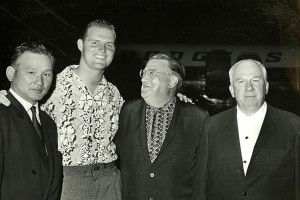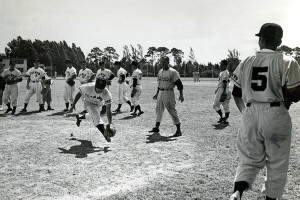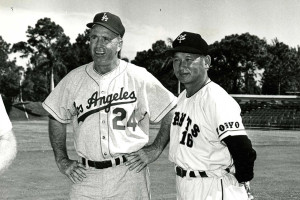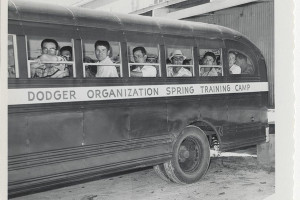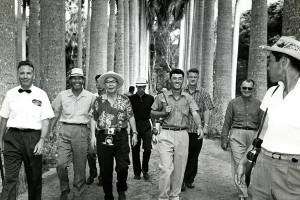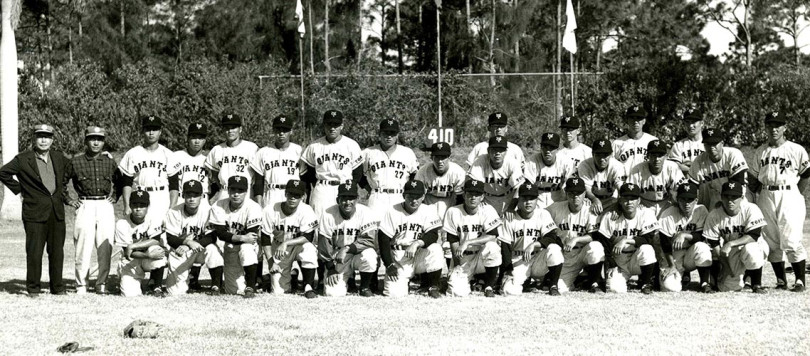
International Teams, Guests Welcomed to Dodgertown, Vero Beach, Florida
By Brent Shyer
Developing and growing international baseball through friendships was one of the significant missions of Dodgertown, Vero Beach, Florida, committed to by Walter and Peter O’Malley.
This they did in a variety of ways, including inviting players, coaches, commissioners, executives, umpires, broadcasters, media, and officials from all over the world to observe training techniques; entire team training alongside the major league Dodgers; meetings with international baseball leaders to discuss baseball in the Olympic Games as a gold medal sport; and almost everything in between. Dodgertown was the vital hub for the international baseball movement. Guests were routinely welcomed to find answers to questions of how to make baseball better and more efficient. Of course, the Dodger organization benefitted from the exchange of ideas, as well. Nine Major League Baseball Commissioners spent time at Dodgertown, plus additional commissioners from other countries visited and stayed there.
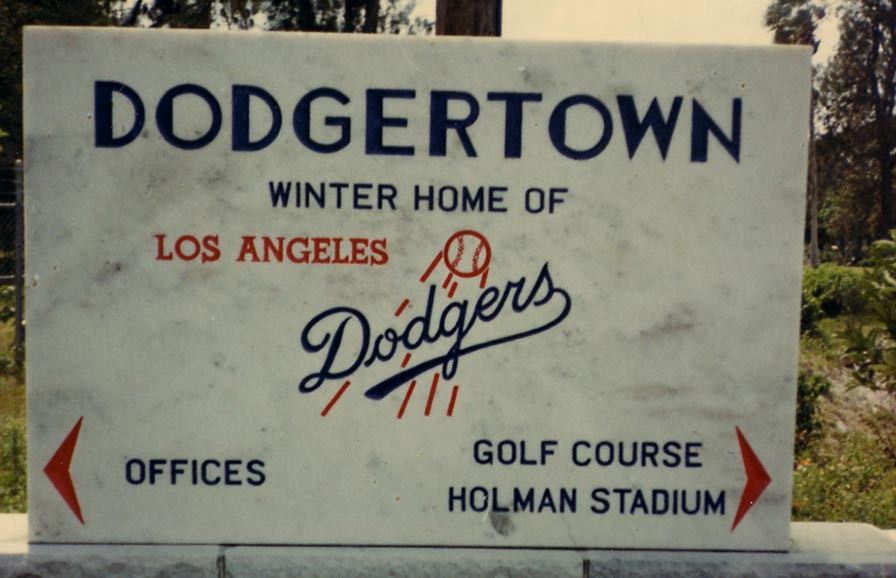
The famous marble Dodgertown marker built by Domar Corp. in Vero Beach identifies the location of Dodgertown offices and Holman Stadium with the Dodger logo.
“There have been more international flags that have flown over Dodgertown than over any other Spring Training camp – that’s for sure,” Maryann Hudson, Los Angeles Times, July 10, 1991 said Peter O’Malley in a 1991 interview. Representatives from Japan, Mexico, South Korea, Dominican Republic, Italy, Russia, Nicaragua, Ireland, Venezuela, Canada, Puerto Rico, Nigeria, People’s Republic of China, Australia have all been guests of O’Malley at Dodgertown.
“Vero Beach deserves a lot of credit,” Peter O’Malley said in 2013. “The number of players that came there, college or professional, met our people. Whether it was a trainer or instructor, and they would see the team from Japan do it differently, we would learn. At that time of the year everybody was at Dodgertown, the trainers, the doctors, those (international) connections would all be established at Dodgertown.” Antonio Morales, Orange County Register, July 18, 2013
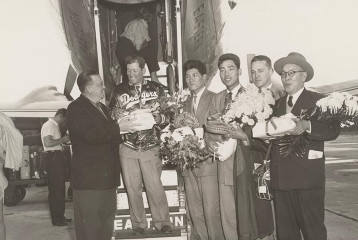
L-R: Dodger President Walter O’Malley; Shigeru Mizuhara, Manager of the Tokyo Yomiuri Giants; pitcher Sho Horiuchi of the Giants; catcher Shigeru Fujio of the Giants; Dick Walsh, Dodgers secretary of minor league operations; Sotaro Suzuki, Japan Hall of Fame sports columnist.
The arrival of representatives of the Tokyo Yomiuri Giants at the Vero Beach Municipal Airport on February 28, 1957. The Giants representatives were invited by Walter O’Malley to Dodgertown, Vero Beach, Florida during Spring Training, following the Dodgers’ 1956 Goodwill Tour to Japan. O’Malley is in the National Baseball Hall of Fame, while Mizuhara and Suzuki are members of the Japan Baseball Hall of Fame. This invitation to Dodgertown for the Giant manager and players started the remarkable relationship of the Dodgers and international baseball.
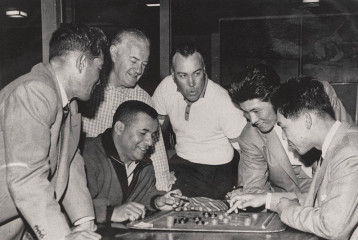
Dodgertown, Vero Beach, Florida
February - March, 1957
Tokyo Yomiuri Giants Manager Shigeru Mizuhara (far left) and two of his players (pitcher Sho Horiuchi, second from right and catcher Shigeru Fujio, far right) were invited by Dodger President Walter O’Malley to visit Dodgertown, Vero Beach, Florida during Spring Training. The Dodgers had a successful 1956 Goodwill Tour to Japan the previous fall. After Mizuhara is Dodger catcher Roy Campanella, Dodger Vice President Fresco Thompson and Dodger center fielder Duke Snider. Mizuhara was inducted into the Japan Baseball Hall of Fame in 1977. Campanella and Snider were inducted into the National Baseball Hall of Fame.
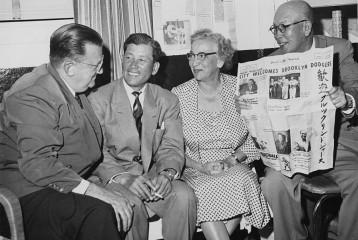
March, 1957 – (L-R) Walter O’Malley; Tokyo Yomiuri Giants Manager Shigeru Mizuhara; Mary Smith, Dodger co-owner; Sotaro Suzuki, Japan Hall of Fame columnist. Yomiuri Manager Shigeru Mizuhara and respected columnist Sotaro Suzuki escorted two Yomiuri players to Dodgertown, Vero Beach, Florida so they could participate in Spring Training on the invitation of O’Malley.
The first of these Dodgertown international visits was in spring, 1957 coming on the heels of the Dodgers’ successful month-long 1956 Goodwill Tour to Japan. Dodger President Walter O’Malley and his family made many friends along the way and he invited the Tokyo Yomiuri Giants Manager Shigeru Mizuhara, a Japan Baseball Hall of Famer, and two of his players – Sho Horiuchi, a right-handed pitcher, and Shigeru Fujio, a catcher – to train with the Dodgers. Respected Yomiuri Shimbun sports columnist Sotaro Suzuki was also invited to Dodgertown. Suzuki, confidant of Matsutaro Shoriki, the “father of professional baseball in Japan,” who had coordinated details of the 1956 Dodger trip, became a good friend of the O’Malley family and was later inducted into the Japan Baseball Hall of Fame.
Walter O’Malley said in 1957, “This is our way of returning the many goodwill gestures of our recent hosts and should give the Japanese manager, his young players and Mr. Suzuki an opportunity to study training methods at our Dodgertown training camp. We feel this exchange of ideas will aid the development of the game of baseball in a country where interest in baseball is truly amazing.” Roscoe McGowen, The Sporting News, February 20, 1957
Many more visits followed and these are some of the highlights:
In 1960, former Mainichi Orions’ star Kaoru Betto visited Dodgertown and, on the request of Orions owner Masaichi Nagata, stayed with the Dodgers throughout the 1960 season. Betto, the 1950 Japan Series MVP, had managed the Orions for seven seasons. After resuming his managerial career with three additional teams, Betto was inducted into the Japan Baseball Hall of Fame as a former player in 1988.
The Dodgers Goodwill Tour to Japan in 1956 was an important first step in the continuing development of baseball in Japan and was just a foretaste to the invitation of the entire Tokyo Yomiuri Giants team to train at Dodgertown in 1961. That was a memorable trip and the Giants arrived February 28 in Vero Beach from Los Angeles on the maiden flight of the Dodger-owned DC-6B airplane. Just having graduated from the University of Pennsylvania, future Dodger President Peter O’Malley became responsible for all arrangements and the Giants’ schedule from their arrival to departure. Dodger clubhouse manager John Griffin welcomed the Giants wearing a long kimono. LIFE magazine, March 17, 1961 Rookie Manager Tetsuharu Kawakami led the Giants, while Walter Alston was manager of the Dodgers. Both men were later inducted into their respective country’s Baseball Hall of Fame.
It was also the first visit for Giants’ legends Sadaharu Oh and Shigeo Nagashima to Dodgertown. Suzuki returned with the Giants and wrote about Dodgertown in a guest column for the Los Angeles Examiner, “The magnificence of this 110-acre site was overwhelming. The scenic beauty of the camp was almost unbelievable.” Sotaro Suzuki, Los Angeles Examiner, March 18, 1961
Peter O’Malley recalled, “When I saw the Tokyo (Yomiuri) Giants in Vero Beach that year, I was very surprised to see that the team owner, front office staff and the players, each recognized their role and took baseball seriously. I think that was the reason why they took in the opinion of our coaches and instructors. They were starving for knowledge and I was impressed with the way they actively participated in our ideas. They had the eagerness to win the Japan Series and second place was not good enough. Not just to be in the pennant race, but to win the Japan Series was their goal.” Tomoya Mori, Baseball Magazine Sha, Japan, April 28, 1997
Dodger President Walter O’Malley sent a telegram to Matsutaro Shoriki on April 7, 1961: “On the eve of the opening of another baseball season allow me to wish you and the Giants every possible success. It is my hope that your Giants and our Dodgers will both emerge victorious at the conclusion of our seasons.” The Giants went on to win the 1961 Japan Series for the first time in six years, followed thereafter by nine consecutive championships from 1965-1973 under Manager Kawakami.
The 1961 visit by the Giants made a profound impact on Oh. In a 2017 letter to Peter O’Malley, he wrote, “Although I have a lot of memories in the 58 years of my professional career, my most sensational event was the Dodgers’ Vero Beach camp in 1961. The Vero Beach camp was so admirable to me and it opened my eyes and totally changed my values in baseball. That experience became the driving force for my endless passion and motivation for baseball and it kept myself involved in baseball so long.” Sadaharu Oh letter to Peter O’Malley, December 7, 2017
In 1962 during Spring Training, newly-named Director, Dodgertown Peter O’Malley hosted Carlos Rubio Alvarez, V.P. and General Manager of the Club Aguila De Veracruz, Mexico.
The next spring, the Dodgers extended an invitation to Boudewijn Maat, an outstanding amateur player from the Netherlands, to travel to Dodgertown from mid-March to April 1. Maat, 19, was a college student who wanted to learn and observe training methods to make him a better player. He was sponsored by the Royal Dutch Baseball Association and a guest of Dodger President Walter O’Malley during his visit.
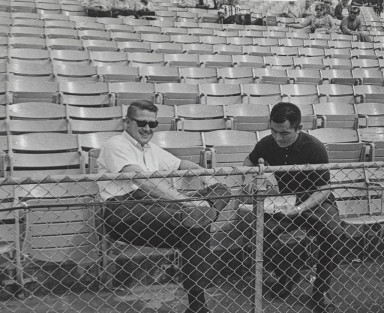
Peter O’Malley and Akihiro “Ike” Ikuhara at Holman Stadium, Dodgertown, Vero Beach, Florida circa 1965. Ikuhara started his Dodger baseball executive career at Dodgertown in the spring of 1965.
In 1965, on the recommendation of friend and author Sotaro Suzuki, Walter O’Malley hired Akihiro “Ike” Ikuhara, a graduate of prestigious Waseda University, Tokyo to work in various departments and learn the business of baseball. Suzuki arrived with Ikuhara at Dodgertown in spring 1965. Ikuhara impressed and was assigned to join Peter O’Malley at the Dodgers’ Spokane, WA. Triple-A farm team in the Pacific Coast League. It was just the beginning for the highly-educated and respected Ikuhara, who later served as a team ambassador and interpreter. In fall 1966, Ikuhara greatly assisted the Dodgers when they made the second Goodwill Tour to Japan.
By 1967, he joined the Dodger front office and many departments utilized his services. In 1982, Ikuhara was named assistant to the president, a post he held until his 1992 passing. He authored two baseball books printed in Japanese (“The Man Who Survives the Race” in 1984; “A Winning Tradition” about the Dodgers in 1985) and, in summer of 2002, was honored with induction into the Japan Baseball Hall of Fame. Ikuhara is the only USA Major League Baseball executive ever inducted into the Japan Baseball Hall of Fame.
In 1965, the Mexico City Tigres sent Ricardo Garza to Vero Beach to help prepare him for a future as a manager by watching and asking questions from the Dodgers.
Suzuki also returned to visit Dodgertown in 1965. In 1966, two Tokyo Yomiuri Giants coaches were at Dodgertown during spring activities – Shigeru Makino, fielding coach and Hiroshi Nakao, pitching coach – to speak with the staff and learn Dodger methods for playing the game.
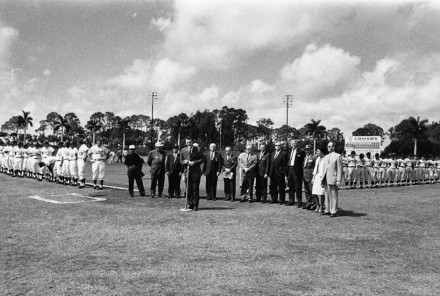
On March 10, 1967, the Los Angeles Dodgers and the Tokyo Yomiuri Giants line up on their respective baselines after introductions of the players before their game at Holman Stadium, Dodgertown, Vero Beach, Florida. The Dodgers defeated the Giants, 5-3. Walter O’Malley is second from left in the front line of dignitaries.
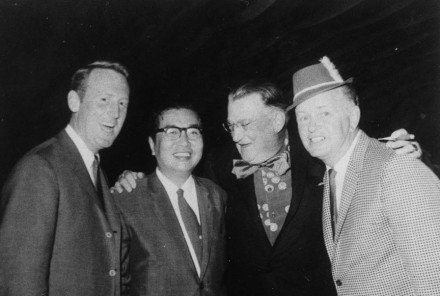
On March 19, 1967, a Sayonara and St. Patrick’s Day Party is held at Dodgertown, Vero Beach, Florida. (L-R) Dodger broadcaster Vin Scully; Toru Shoriki, owner, Tokyo Yomiuri Giants; Dodger President Walter O’Malley; and Dodger broadcaster Jerry Doggett.
The Tokyo Yomiuri Giants returned to Dodgertown for the second time in Spring, 1967, arriving at the Vero Beach Municipal Airport on the Dodger-owned Lockheed Electra II airplane, “Kay O’”. Seven members of the Giants’ roster and coaching staff were either in or later inducted into the Japan Baseball Hall of Fame, in addition to Hall of Fame sports columnist and trip coordinator Suzuki. Yomiuri founder and owner Matsutaro Shoriki wrote a letter to Dodger President Walter O’Malley on April 4, 1967, stating in part: “I wish to express to you my profound appreciation and thanks for the warm welcome and generous hospitality you and your staff extended to Toru (Shoriki’s son) and our players during their spring training in Vero Beach. It is no exaggeration to say that without what you and your people did for them it would not have been possible for them to see and learn so much of the American baseball in such a short period…I am sure we will have more occasions in future to work together in order to strengthen the close and friendly ties which already exist between our two teams.”
The Dodgers played a goodwill exhibition game against Yomiuri at Holman Stadium, Dodgertown on March 10, as Baseball Commissioner William Eckert threw the ceremonial first pitch prior to the start of the contest won by L.A., 5-3.
Before the Giants departed in 1967, O’Malley had a slight variation of his annual St. Patrick’s Day gala, as executives, staff and VIP guests at Dodgertown celebrated St. Joseph’s Day on March 19 in combination with a Sayonara party in honor of the Giants’ visit. That spring O’Malley had Dodgertown menus printed in Japanese as well as English. The Giants won the 1967 Japan Series.
Also in 1967, Masaichi Nagata, owner of the professional Tokyo Orions, was a guest of the O’Malley’s.
In 1968, Yoshio Kitagawa, pitching coach of the Tokyo Yomiuri Giants’ farmhands, brought Tsuneo Horiuchi and Toshiharu Usami to Dodgertown. Both players appeared in Dodger exhibitions. Right-hander Horiuchi was inducted into the Japan Baseball Hall of Fame in 2008 for his outstanding career with 203 wins in 18 seasons for Yomiuri. He also managed the Giants in 2004 and 2005. Hiroshi Tsuchiya, retired from the Chunichi Dragons, spent the entire spring at Dodgertown.
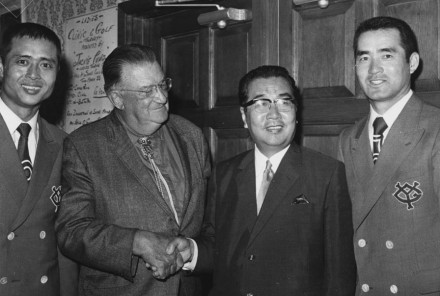
Yomiuri Giants slugger Sadaharu Oh, Walter O’Malley, Giants President Toru Shoriki and Giants four-time Japan Series MVP Shigeo Nagashima enjoy another cultural exchange at Dodgertown in 1971. The Giants won the 1971 Japan Series.
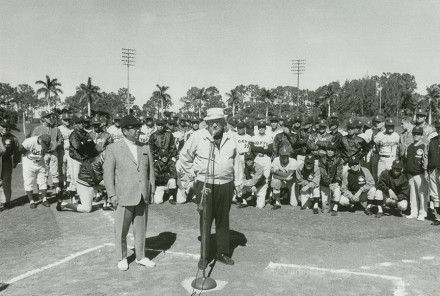
On March 12, 1971, Dodger Chairman of the Board Walter O’Malley is at the microphone to welcome the Tokyo Yomiuri Giants and their owner (left) Toru Shoriki to Holman Stadium, Dodgertown, Vero Beach, Florida, marking the third visit made by the Giants to conduct pre-season workouts in Dodgertown. The Giants won their seventh consecutive Japan Series in 1971.
The 1971 Tokyo Yomiuri Giants set up their training camp alongside the Dodgers at Dodgertown. It was the third time a Giants team had trained at Dodgertown. The Giants beat the Dodgers, 5-3, in front of 4,268 fans at Holman Stadium in a goodwill game. Also in 1971, Peter O’Malley made arrangements for Sadayuki Tokutake, a retired bonus player with the professional Yakult Swallows, who later finished his playing career with Chunichi, to observe Dodger camp and spend the whole summer in Los Angeles for further study. During his stay, Ikuhara was on hand to assist him with various Dodger front office departments. Tokutake also attended the All-Star Game in Detroit, along with Masanori Ochi, the color commentator for Nippon Television Network and a sportswriter in Japan.
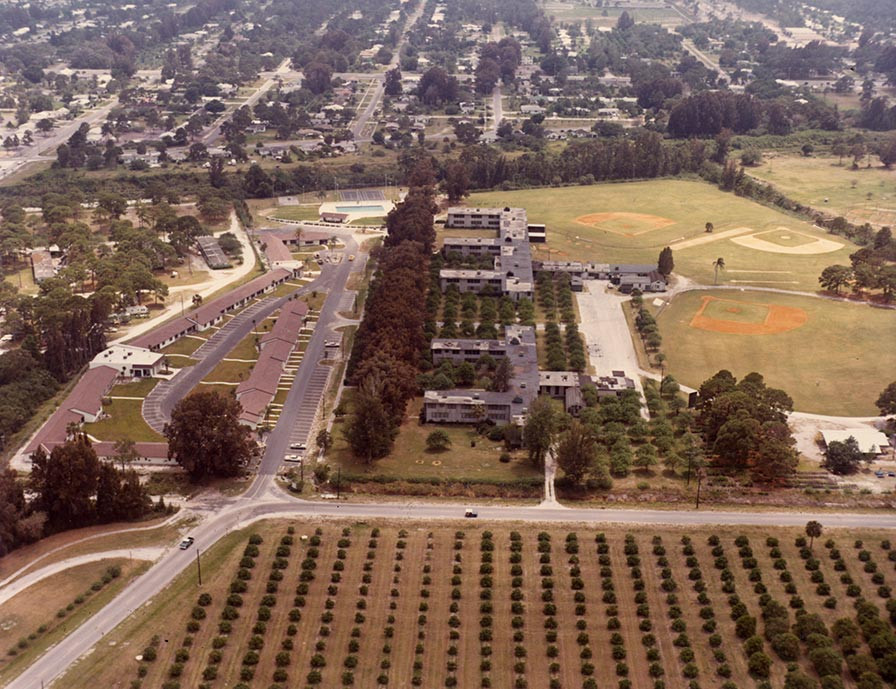
Aerial photo, circa 1972, of Dodgertown, Vero Beach, Florida showing the newly-built accommodations for sleeping on the far left and the old U.S. Navy barracks (center) near Fields 1 and 2 (far right).
In March, 1973 two coaches and two players from Italy were invited to Dodgertown to participate in workouts. Italian National Coach Salvano Ambrosioni was thrilled when Dodger Coach Tommy Lasorda, who spoke Italian, took him under his wing and invited him to attend Dodger staff meetings with him.
In 1975, new Manager Shigeo Nagashima led the Tokyo Yomiuri Giants back to Dodgertown from March 2-15 to train for the fourth time. Nagashima is a Japan Baseball Hall of Famer.
In March, 1979, Roy Saiki, General Manager of the Tokyo Yomiuri Giants and Shigeru Makino, former Giants coach, observed the Dodger training camp at Dodgertown.
Following the August 9, 1979 passing of Walter O’Malley his longtime international friends showed great respect. In Tokyo, the Yomiuri Giants and Taiyo Whales stood for a moment of silence before the game and “prayed for the repose of O’Malley’s soul” to honor the memory of the Dodger Chairman of the Board. O’Malley became a Dodger stockholder in 1944, served as Dodger President from 1950-1970, and then Chairman from 1970-1979.
In February 1980, Dodger President Peter O’Malley traveled to Japan to meet with Tokyo Yomiuri Giants owner Toru Shoriki. They reached a “friendly agreement” for more front office and coaching exchanges. From March 9-25, 1980, O’Malley invited representatives of the Giants to visit Dodgertown, including Toshimitsu Suetsugu, minor league batting coach; Nobuyoshi Suzuki, minor league infielder; Yasuhiro Hayashi, rookie pitcher (top draft selection in 1979); and Akihiro Yamazaki, rookie catcher (second draft pick in 1979).
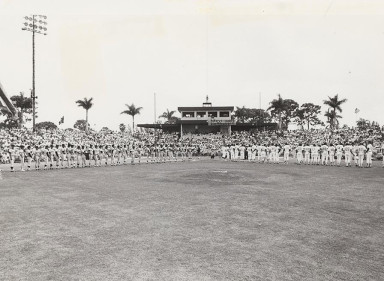
Dodgertown, Vero Beach, Florida
Spring Training 1981
Tokyo Yomiuri Giants
In 1981, the entire Tokyo Yomiuri Giants team returned to Dodgertown for their fifth and final visit, February 28-March 16. Following their five team spring training visits preparing for the season at Dodgertown, the Tokyo Yomiuri Giants won four Japan Series championships (1961, 1967, 1971 and 1981).
One of the most popular figures during these camps was Giants’ slugger Sadaharu Oh, the world’s all-time home run leader (868), who played on 11 Japan Series championship teams. “We could see how togetherness came about through a well-organized program,” said Oh of the Dodgertown experience. “I saw that a veteran player should work harder. Some of the busiest workers among the Dodgers in camp are their most experienced men. Spring training should not only be physical preparation. It also should be mental readiness. It is obvious that victory comes from team play. This you can gain in a place like Dodgertown. It brings everyone together more.”
In all, 21 members (nearly 10 percent) of the Japan Baseball Hall of Famers trained at and/or visited Dodgertown.
In 1984, Korea Baseball Organization advisor and broadcaster Heo Koo-Yeon was invited to visit Dodgertown during spring training. Heo recalled, “That, in the big picture, changed and influenced my life. It also influenced Korean baseball a lot. I would say it was the turning point of our nation’s baseball. O’Malley enthusiastically told me to come over and treated me well.” Sung Min Kim, Fangraphs.com, June 14, 2019 O’Malley introduced him to Dodger General Manager Al Campanis and Dodger Manager Tommy Lasorda telling them, “Let Mr. Heo do whatever he wants at the camp. He has no limitations.” Ibid. Heo took all that he learned back to South Korea as a baseball advisor and educated his listeners on the broadcasts. That experience eventually led him to his March, 2022 election as the Commissioner of Baseball in South Korea.
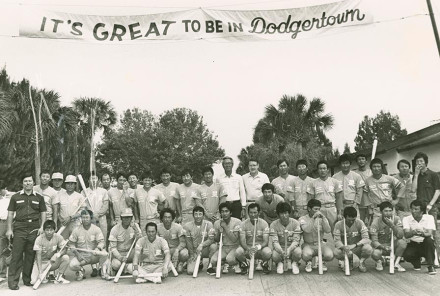
The professional Samsung Lions of the Korean Baseball Organization (KBO) visit Dodgertown, Vero Beach, Florida for training purposes from February 27-March 14, 1985. They also played a game against the Dodgers on March 9. It is the first time a professional Korean team would conduct spring training with a major league club. Here the team is provided with commemorative baseball bats by Dodger President Peter O’Malley, shown in the back row to the right of center. The Lions had 25 players led by Manager Kim Young Duck and five coaches, plus front office personnel and five reporters.
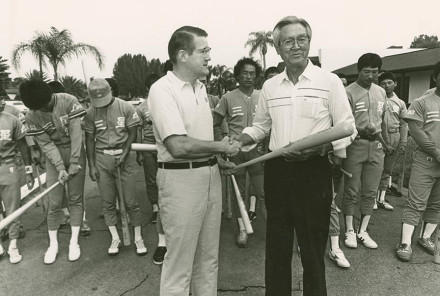
On March 12, 1985, Dodger President Peter O’Malley greets Korean Baseball Commissioner Gen. Jyong-Chul Suh at Dodgertown, Vero Beach, Florida with members of the professional Samsung Lions of the Korean Baseball Organization (KBO) behind them. The Lions trained at Dodgertown from February 27-March 14, 1985. The Lions played an exhibition game against the Dodgers on March 9, 1985 marking the first Korean team to play an exhibition against a U.S. major league team and Commissioner Suh was in attendance along with Baseball Commissioner Peter Ueberroth. Former Baseball Commissioner Bowie Kuhn was also in attendance.
The professional Samsung Lions of the Korean Baseball Organization were initially invited by O’Malley to train for two weeks at Dodgertown in Spring, 1985. The Dodgers were the first professional team to host a South Korean professional baseball team. The Lions returned to Dodgertown in 1992, 1993, 1995 and 1997. On March 9, 1985, Baseball Commissioner Peter Ueberroth and the Commissioner of Baseball in South Korea General Jyong-Chul Suh were guests at Dodgertown and took part in first pitch ceremonies. Former Baseball Commissioner Bowie Kuhn was also in attendance. March 9 was declared as “Samsung Lions Day” in Vero Beach. The Dodgers defeated the Lions, 7-0, at Holman Stadium, in a historic exhibition game, televised on KTTV Channel 11 in Los Angeles, marking the first South Korean team to play a major league team.
Samsung Manager Kim Young Duck said the opportunity to train in Dodgertown was beneficial. “The main purpose we are here is to bring the level of baseball up (in South Korea),” said Kim. Tom Riggs, Vero Beach Press Journal, March 5, 1985
On March 12, O’Malley presented specially engraved bats to Commissioner Suh and all the South Korean team members and guests. A bronze plaque commemorating this historic visit was placed in Holman Stadium, Dodgertown, on a wall adjacent to the press box.
In 1986, O’Malley invited three Chinese national coaches (Song Ping-Shan from Beijing, Sher Wei-Ji from Shanghai, and Tu Ming-Hui from Sichuan) to Dodgertown to observe during Spring Training. Also at Dodgertown was Youde Liang, vice president of the Baseball Association of the People’s Republic of China and a prominent baseball author. That same spring, the Tokyo Yomiuri Giants sent retired star pitcher Shoji Sadoaka and pitching coach Shitoshi Sekimoto to Dodgertown to learn techniques from the Dodgers.
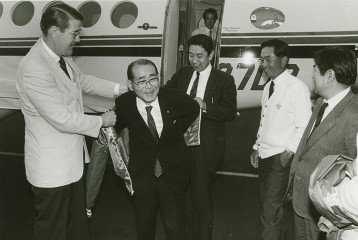
L-R: Peter O’Malley; Miichiro Katoh, owner of Chunichi Dragons; unknown; Akihiro “Ike” Ikuhara, assistant to Dodger President Peter O’Malley; unknown. Dodger President Peter O’Malley welcomes Chunichi Shimbun Chairman and Chunichi Dragons owner Miichiro Katoh with a Dodger jacket at the Vero Beach Airport adjacent to Dodgertown, Vero Beach, Florida. The professional Chunichi Dragons trained at Dodgertown for two and a half weeks, February 16-March 5, 1988 and played the Dodgers during an exhibition game on March 3.
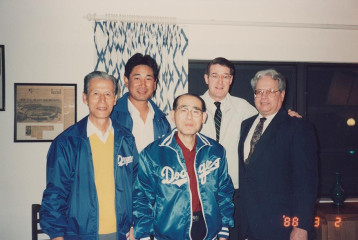
March 2, 1988, Dodgertown, Vero Beach, Florida, Spring Training. The professional Chunichi Dragons of Nagoya trained at Dodgertown on the invitation of O’Malley. (L-R): Satoru Nakayama, President, Chunichi Dragons, Japan; Senichi Hoshino, Manager, Chunichi Dragons; Miichiro Katoh, owner, Chunichi Dragons; Dodger President Peter O’Malley; Dr. Creighton Hale, President, Little League Baseball.
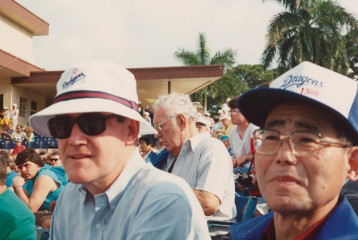
(L-R) Peter O’Malley, President, Los Angeles Dodgers (1970-1998) hosts Miichiro Katoh, owner of the professional Chunichi Dragons from Japan on March 3, 1988, to the exhibition game between the two teams at Holman Stadium, Dodgertown, Vero Beach, Florida. The Chunichi Dragons trained at Dodgertown from Feb. 16-March 5, 1988 on the invitation of O’Malley. The Dragons would cap off their 1988 season with a Central Leauge championship, the first pennant in six seasons and were appreciative of the instruction they received at Dodgertown during spring training.
For the first time a team from Japan other than Yomiuri visited Dodgertown. On the invitation of O’Malley in 1988, Japan’s professional Chunichi Dragons spent two and a half weeks training at Dodgertown. The previous season, O’Malley made special arrangements for two Dragons rookies to play for the Sarasota Dodgers farm team (Takeshi Yamasaki and Tetsuo Arakawa). On March 2, 1988, Miichiro Katoh, owner of the Dragons and chairman of the board of Chunichi Shimbun arrived at Dodgertown and was welcomed by O’Malley who presented a Dodger jacket to him. Katoh attended the Dodgers – Dragons game the next day.
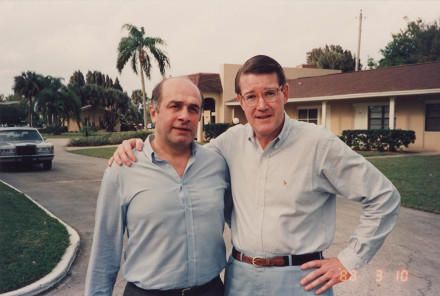
March 10, 1988
Dodgertown, Vero Beach, Florida
(L-R) Ramaz Goglidze, of Georgia, President, Soviet Baseball Federation. Peter O’Malley.
Ramaz Goglidze was the first president of the USSR Baseball Softball Federation and an important support for international baseball development and served from 1987 to 1991. From 1992-1997, Goglidze expanded his leadership for international baseball by serving as 1st vice president for the European Baseball Federation. He was prominent in the support of the country of Georgia to be involved in the Olympic Games and was a founder of the Georgian National Olympic Committee.
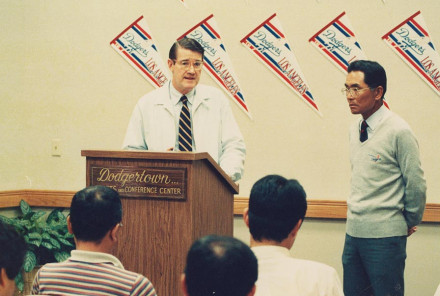
While Japan’s professional Chunichi Dragons are training at Dodgertown, Vero Beach, Florida, two baseball coaches from Russia — Alexander Ardatov and Gela Cheehradze — are introduced at a press conference held by Dodger President Peter O’Malley. Interpreting for the Japanese media is Akihiro “Ike” Ikuhara next to O’Malley, his longtime assistant. Dodgertown was the site of numerous cultural and international baseball exchanges.
It was a memorable spring in 1988, as Ramaz Goglidze, of Georgia and President of the Soviet Baseball Federation, was invited to Dodgertown from March 7-10, along with Russian baseball coaches Alexander Ardatov and Gela Cheehradze. Members of the International Baseball Association (IBA) and the U.S.S.R. Baseball Federation were introduced in pregame ceremonies before the Dodgers – Baltimore game at Holman Stadium, Dodgertown. All were guests of O’Malley, including Jong Nak Kim, continental vice president for Asia; Eiichiro Yamamoto, IBA first vice president; IBA President Dr. Robert Smith; and Goglidze. A week later, Monchin Pichardo, president of the Licey Tigres club in Santo Domingo, Dominican Republic, spent a week at Dodgertown as O’Malley’s guest.
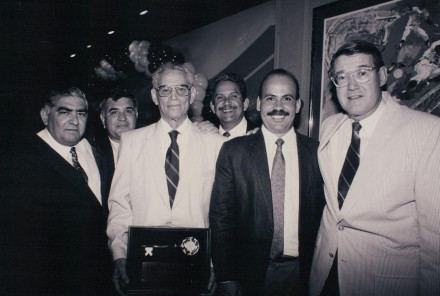
Dodger President Peter O’Malley (right) recognizes Licey Tigres President Monchin Pichardo (second from left) of the Dominican Republic with a “Key to Dodgertown” during the annual St. Patrick’s Day, March 17, 1993 celebration at Dodgertown, Vero Beach, Florida. Pichardo was surrounded by his friends from the Dominican Republic, also guests of O’Malley.
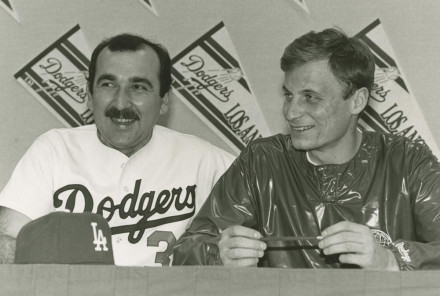
Two Russian baseball coaches visit Dodgertown, Vero Beach, Florida from February 22-26, 1988 to learn more about training techniques and meet Dodger players, coaches and executives. L-R: Guela Chikhradze and Alexander Ardatov are the coaches invited by Dodger President Peter O’Malley as guests of the Dodgers.
The Dodgers established a longtime agreement with Pichardo’s team during Dominican Winter Ball. Pichardo was invited to Dodgertown each spring and on March 17, 1993, O’Malley presented him with a “Key to Dodgertown.”
A career-changing event took place at Dodgertown in the spring of 1988. Chunichi Manager Senichi Hoshino, a Japan Baseball Hall of Famer, requested to O’Malley that left-handed pitcher Masahiro Yamamoto stay with the Vero Beach Dodgers in the Single-A Florida State League under the watchful eye and instruction of Akihiro “Ike” Ikuhara, himself a former Asia University head baseball coach and former player at Waseda University, Tokyo. O’Malley gladly approved and Ike took to instructing and helping Yamamoto, who was on the verge of being released. Ike told him, “Never give up. If you do, that’s the end.” With constant encouragement and working on the young pitcher’s mechanics, which included helping him with a screwball as a new pitch, Ikuhara was delighted with Yamamoto’s progress. The young pitcher had a 13-7 record for Vero Beach. Upon Yamamoto’s return to Japan late in the season, he went 5-0 and helped the Dragons win the 1988 Central League Championship.
Yamamoto would have even greater success, as he completed 29 seasons with Chunichi, accumulating 219 wins until his retirement in 2015 at age 50. In 2008, as a tribute to Ike, who passed away in 1992, when Yamamoto won his 200th game, he put the game ball in front of Ike’s photograph at his home. In 2016, Yamamoto selected Dodgertown as the place where he wanted to film a segment about his relationship with Ike for Japan’s prestigious nationwide show “Another Sky.” The format of the Nippon TV Network program features an interview with a guest at their most memorable place in the world and Yamamoto selected Dodgertown because it turned his career around in 1988. In 2022, Yamamoto was inducted into the Japan Baseball Hall of Fame.
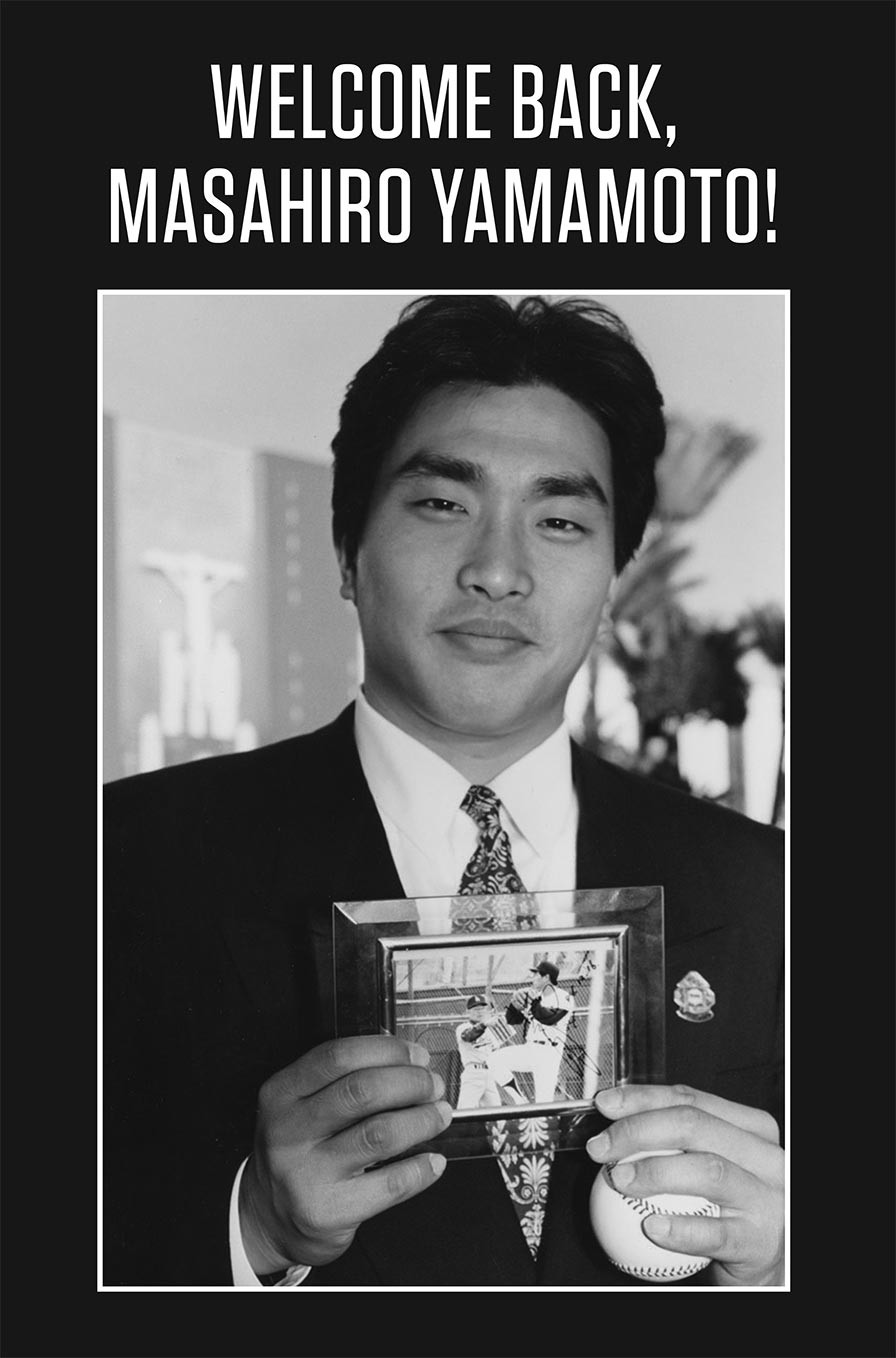
Masahiro Yamamoto, a 2022 Japan Baseball Hall of Fame left-hand pitcher, returned to Dodgertown, Vero Beach, Florida to film the prestigious nationwide show “Another Sky” in Japan. In 2016, Yamamoto selected Dodgertown as the Nippon TV Network program features an interview with a guest at their most memorable place in the world and Yamamoto selected Historic Dodgertown because it turned his baseball career around in 1988. Yamamoto was a promising young pitcher for the Chunichi Dragons when the team visited Dodgertown in 1988. The Dragons, wanting to accelerate his development asked the Dodgers if he could pitch in their minor league system under the personal coaching of Akihiro “Ike” Ikuhara.
In 1989, O’Malley made a historic arrangement for three pitchers from the Chunichi Dragons of Japan to play for the Single-A minor league Vero Beach Dodgers and the Kissimmee Dodgers of the Gulf Coast League during the 1989 season. Yashiro Kawabata and Masaaki Kamanaka played for Vero Beach, while Koji Takahashi pitched for Kissimmee.
Two South Korean coaches from the Samsung Lions spent two weeks at Dodgertown in March-April, 1990 watching how the Dodgers conducted their instruction and workouts.
In 1991, O’Malley invited Carlos Garcia, the new Nicaraguan Minister of Sports and four baseball coaches from Nicaragua to be his guest at Dodgertown during Spring Training. In appreciation for the longtime friendship, Garcia had the Nicaraguan team wear uniforms styled exactly after the Dodgers’ script. “That is to honor the organization that has sent us baseballs, gloves, and had four of our coaches as their guests in spring training this year,” said Garcia. Phil Hersh, Chicago Tribune, August 5, 1991 Garcia was invited every spring to Dodgertown and, in 1992, O’Malley privately built “Dodgers Little League Friendship Field” in Managua to support the development of youth baseball in Nicaragua.
From July 13-21, 1991, the Dodgers welcomed the Nigerian National Baseball team (ages 16-18) to Dodgertown as it prepared for the IBA’s Youth Baseball Championships in Brandon, Manitoba, Canada. O’Malley said at the time, “All of us in the Dodger organization are proud to host the National Baseball Team from Nigeria at Dodgertown and we’ll do everything possible to make their stay at Dodgertown worthwhile.”
In 1992, on the invitation of O’Malley, 26-year-old Kazushige Nagashima, son of Japan Baseball Hall of Famer and Yomiuri star Shigeo Nagashima, spent the season playing for the Vero Beach Dodgers Single-A team under the supervision of Ike Ikuhara, assistant to Dodger President Peter O’Malley. The third baseman left Nippon Professional Baseball for the 1992 season, after struggling at the plate for his first four seasons. He returned to Japan and played for the Yomiuri Giants from 1993-1996.
At the 1992 Olympic Games in Barcelona, Spain, baseball made its first appearance as a gold medal sport. In previous Olympic Games, baseball had been an exhibition sport. In 1979, O’Malley hosted nearly 100 members of the international baseball community in Los Angeles for their AINBA Baseball Congress. Dr. Bob Smith, IBA President; former Baseball Commissioner Bowie Kuhn; O’Malley; and Rod Dedeaux, legendary University of Southern California head baseball coach had worked tirelessly advocating gold medal status for baseball in the Olympic Games. They traveled extensively to numerous countries, conducted countless meetings and made phone calls, developed friendships, worked with baseball and government leaders, and sports officials to seek assistance and secure votes from IOC members for gold medal status. O’Malley welcomed international guests to Dodgertown for decades. With the success of the eight-team exhibition baseball tournament at Dodger Stadium during the Games of the XXIII Olympiad, Los Angeles in 1984, the IOC approved baseball as an official Olympic sport on October 13, 1986 with its first appearance in Barcelona.
Dr. Smith, IBA President from 1981-1993 said: “The Dodgers have been absolutely marvelous in what they have done to help the game internationally. No organization has done more, and few have come anywhere close. Peter O’Malley has one of the biggest views toward the future of developing baseball around the world. Since the AINBA Baseball Congress in 1979, virtually everything that has been done in the area of international baseball has the fingerprints of the Dodger organization. I believe that Peter O’Malley is probably the single-most important person in getting baseball into the Olympics.”
On January 30, 1993, the Samsung Lions defeated the Moscow Red Devils, 7-0, at Dodgertown, marking the first-ever meeting between a Korean professional team and a Russian team. O’Malley welcomed Commissioner of Baseball in South Korea, Sang-Hoon Lee, to Dodgertown for the significant occasion.
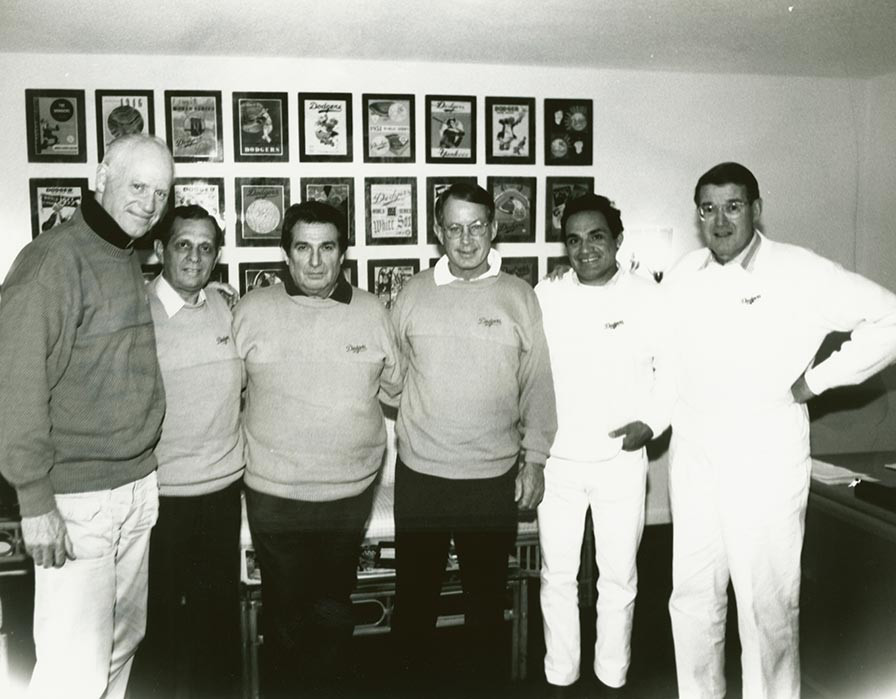
(L-R) Former Baseball Commissioner Bowie Kuhn; Carlos Garcia, Minister of Sports, Nicaragua; Aldo Notari, President, International Baseball Federation; Dr. Bob Smith, Greenville College (IL); Alonso Perez, President of Mexican Baseball Federation; and Peter O’Malley. On March 15, 1993 at Peter O’Malley’s office in Dodgertown, Vero Beach, Florida, Notari, Garcia and Perez were all vying for the IBA presidency to succeed Dr. Bob Smith. Notari was eventually elected that year and moved the IBA headquarters to Lausanne, Switzerland and renamed the IBA, the IBAF.
On March 15, 1993, IBA President Dr. Smith, former Baseball Commissioner Kuhn, Aldo Notari from Italy, Nicaragua’s Minister of Sports Garcia and Alonzo Perez from Mexico were invited to Dodgertown by O’Malley for meetings. Garcia, Notari and Perez were all vying for the IBA presidency later that year to succeed Dr. Smith. Notari was eventually elected president and served for the next 13 years. Garcia returned to Dodgertown as O’Malley’s guest on March 17, 1994.
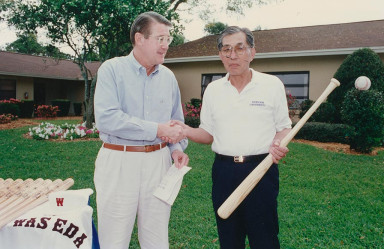
Dodgertown, Vero Beach, Florida, March 1, 1994.
L-R: Dodger President Peter O’Malley presents Waseda University Head Baseball Coach Renzo Ishii with an inscribed bat from Waseda’s visit to train at Dodgertown for two weeks (February 17-March 1), marking the first time a collegiate team trained alongside the major league Dodgers. Ishii was posthumously inducted into the Japan Baseball Hall of Fame in 2020.
The baseball team from highly-respected Waseda University of the Tokyo Big 6 Baseball League, was invited by O’Malley to train at Dodgertown from February 17-March 1, 1994. It was the first time an amateur team had visited Dodgertown and trained alongside the MLB Dodgers. “We are very happy to have one of Japan’s most prestigious college baseball teams join us at Dodgertown,” said Dodger President Peter O’Malley. “Their coach, Renzo Ishii, is a longtime friend and is one of the best known amateur coaches in the world.” In 2020, Ishii was posthumously inducted into the Japan Baseball Hall of Fame.
On March 17, 1994, Arturo Gil, president of the Azucareros Del Este team in the Dominican Republic, visited Dodgertown.
In spring 1994, Chan Ho Park made baseball history and courageously carried the weight of a nation on his shoulders. As the first South Korea-born player to sign a groundbreaking Major League Baseball contract for the Dodgers, Park had a successful career and was a pioneer who opened the door for 25 more from his country (through the 2023 season) to pursue their big league dreams.
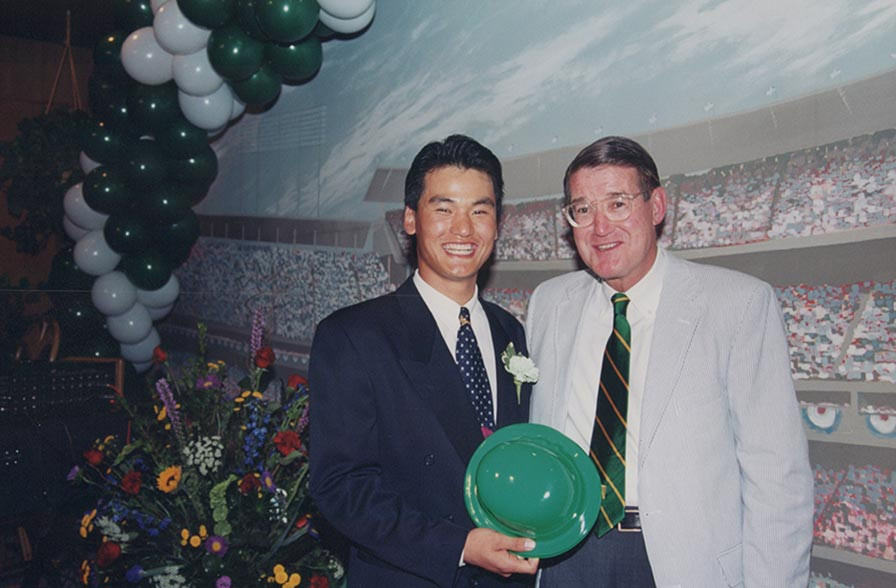
On March 17, 1994, rookie pitcher Chan Ho Park (left) of South Korea is invited to attend the annual St. Patrick’s Day party at Dodgertown, Vero Beach, Florida by Dodger President Peter O’Malley (right). At one point in the festivities, Park was introduced to the appreciative crowd when he came out with a green Irish derby. Park said for the day his name had now been changed to “Chan O’Park,” putting an Irish spin to his Korean name.
Peter O’Malley’s free agent signing of Park on January 14, 1994, brought the right-handed pitcher first to Dodgertown and on February 19, he threw in the batting tunnels, as his scheduled performance at Holman Stadium was rained out.
Despite the cultural and language differences, Park, from Kong Ju City, won in double figures for the Dodgers five straight seasons (1997-2001). He enjoyed 17 seasons in MLB, including nine with the Dodgers (1994-2001, 2008). Park won 124 games, the most of any pitcher from Asia and pitched in three postseasons, including the 2009 World Series for the Philadelphia Phillies. He pitched in 1,993 innings and had 1,715 strikeouts.
After his playing days in the United States in 2010, Park pitched one season for the Orix Buffaloes of Nippon Professional Baseball in Japan and one year for the professional Hanwha Eagles of the Korean Baseball Organization in South Korea, where he remains one of the nation’s most respected and popular athletes.
Baseball history was made on February 13, 1995. That was the date O’Malley and the Dodgers signed right-handed pitcher Hideo Nomo, who was the first Japan-born player to appear in the major leagues since Masanori Murakami pitched for the San Francisco Giants in 1964-1965, before returning to play in Japan’s professional league. But Nomo stayed and completed his extraordinary MLB career.
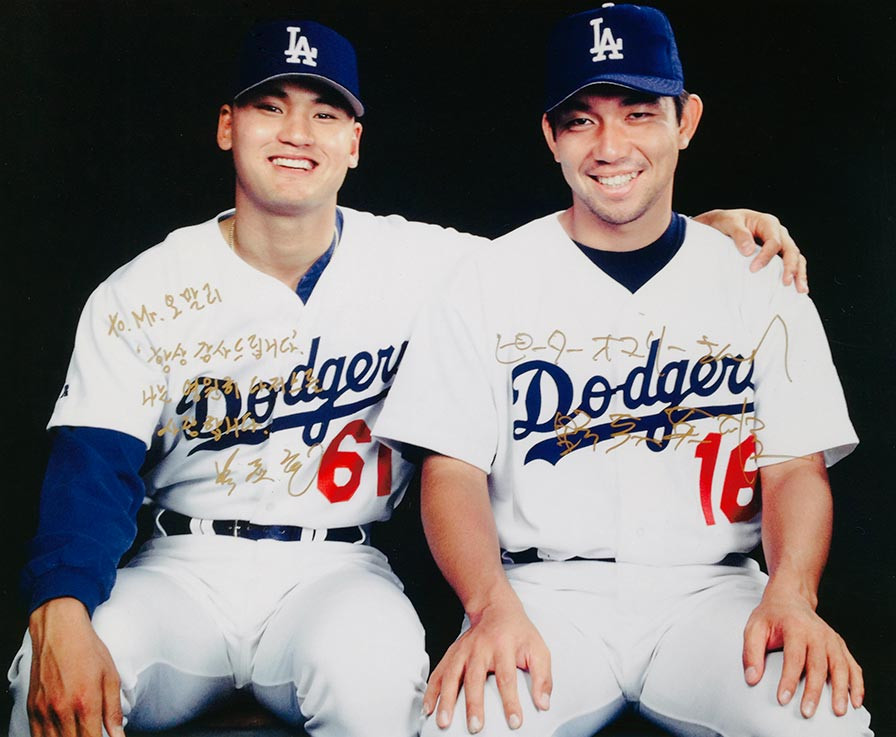
Two of the most significant signings in baseball took place in back to back years, 1994 and 1995, when Chan Ho Park and Hideo Nomo joined the Dodgers from South Korea and Japan, respectively. Their success opened the door for more players from those two Asian countries to play Major League Baseball. In 1995, the two signed this photo to Dodger President Peter O’Malley.
Jon SooHoo, Dodger photographer
Beginning his career in the U.S. at Dodgertown, hordes of media from Japan documented Nomo’s every move. On July 11, 1995, Nomo was the National League starter for the All-Star Game at Texas and won the 1995 National League Rookie of the Year award. He started his major league career with the Dodgers going 13-6 with a 2.45 ERA in 28 starts. It touched off the phenomenon known as “Nomomania” as fans in Japan and America were enthralled by him and supported his every performance. Giant television screens were installed on buildings and street corners in 13 cities throughout Japan to show his every Dodger start live. Stadiums throughout the country were sold out when Nomo pitched. The Japanese-American community in Los Angeles, as well as other cities, were beaming with pride at his achievements.
Twice Nomo led the league in strikeouts – with 236 in the N.L. for the 1995 Dodgers and 220 in the American League for the 2001 Boston Red Sox. In 12 major league seasons, Nomo won 123 games while playing for the Dodgers (from 1995-1998 and 2002-2004), New York Mets (1998), Milwaukee (1999), Detroit (2000), Boston (2001), Tampa Bay (2005) and Kansas City (2008) before retiring.
He also fired two no-hitters, one for the Dodgers on September 17, 1996 at Coors Field in Denver, Colorado, and one for Boston on April 4, 2001 at Baltimore in his Red Sox debut. Only five pitchers in baseball history have thrown a no-hitter in both leagues. Nomo was no stranger to success, as he pitched consistently for Kintetsu in Japan where he won 78 games. Nomo’s desire was to challenge the best hitters in baseball in the United States. His signing forever changed baseball’s landscape in America and Japan. Credit should go to Nomo for learning a new culture and performing in unfamiliar circumstances. O’Malley’s signing of Nomo and Nomo’s longevity and success opened the door for more than 65 Japan-born players (through the 2023 season) to follow his footsteps and perform in Major League Baseball.
In March, 1996, Irish baseball players and coaches Mick Manning of Templeogue and Mike Kindle of Monkstown were invited by O’Malley to visit Dodgertown. Both Manning and Kindle coached for the Irish Baseball and Softball Association, overseeing players in the Dublin Youth Baseball League and the Irish National Baseball team. Longtime volunteer for Baseball Ireland, Manning returned to Historic Dodgertown in June, 2013 and again in 2014 when he was a member of the executive board of the European Baseball Federation (C.E.B.). In 1998, O’Malley privately built two baseball fields in West Dublin, Ireland – one for adults and one for youth.
In 1996, pioneer pitcher Park was proud to have his collegiate team, Hanyang University from Seoul, South Korea, train at Dodgertown from February 17-March 1. After going 5-5 in for the Dodgers that season, in 1997 Park became a full-time starter and enjoyed five straight seasons with double figure victories.
On February 24, 2014, the Italian National baseball team arrived at Dodgertown to begin training for the European Championships. From March 3-8, 2016, the baseball team from prestigious Meiji University, part of the Tokyo Big 6 Baseball League, visited Historic Dodgertown for training.
In preparation for the 2017 World Baseball Classic, the Italian National Team spent February 23-March 4 training at Dodgertown.
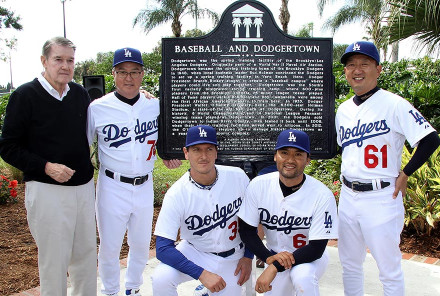
November 10, 2014
The unveiling of the Historic Dodgertown marker as a Florida Heritage Landmark was held.
L-R: Historic Dodgertown Chairman Peter O’Malley; Kyung Moon Kim (Manager of South Korea’s NC Dinos); Alberto Furlani (Italy) ; Chan Ho Park, Dodger great and Dodger camp instructor from South Korea; and Tai Il Lee, South Korea’s professional NC Dinos president and CEO.
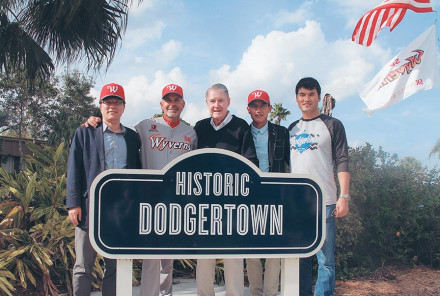
March, 2018, Dodgertown, Vero Beach, Florida
L-R: J.Y. Yoo, SK Wyverns president; Trey Hillman, manager of the Wyverns; Peter O’Malley; Yeom Kyuing Yup, general manager of the Wyverns; and Chan Ho Park.
Hillman managed the Wyverns in 2017 and 2018. The professional Wyverns of the Korean Baseball Organization (KBO) made annual visits to Dodgertown for training purposes beginning in 2012 through 2018, when Peter O’Malley turned over the Historic Dodgertown, Vero Beach, Florida complex to Major League Baseball. The 2018 Wyverns defeated the Doosan Bears to win the Korean Series, their equivalent of a Korean Baseball Championship. Chan Ho Park made baseball history when he made his debut with the Dodgers on April 8,1994 becoming the first South Korean born player in the major leagues. Park would win 124 games in the majors, becoming the all-time Asian born winningest pitcher.
The professional SK Wyverns of the Korean Baseball Organization (KBO) made annual training visits for seven years (2012-2018) when O’Malley was responsible for Historic Dodgertown and they won the KBO Championship in 2018. On February 16-17, 2018, the Korean Baseball Commissioner Chung Un-Chan, the country’s former Prime Minister (2009-2010), visited Historic Dodgertown to greet the Wyverns.
From November 10-22, 2017, the Chinese Men’s National Baseball Team trained at Historic Dodgertown and played three exhibition games at Holman Stadium. In a unique opportunity, a U.S. facility served as the training hub for two National Teams (women’s softball as well) from an international country (China), as they prepare for competition and their respective upcoming seasons, and ultimately the 2020 Tokyo Olympic Games. John McLaren, head coach of the Chinese Men’s National Baseball Team, said: “This has been a great experience. Everything we need is here, including lots of fields, batting cages, dormitories and 60 years of Major League Spring Training history.”
In 2018, both the Chinese Men’s National Baseball Team and the Chinese Women’s Fast-Pitch Softball Team returned to Historic Dodgertown for another round of training. That was the O’Malley family’s final year responsible for Historic Dodgertown before Major League Baseball took the baton in 2019 and renamed the site the “Jackie Robinson Training Complex.”


